Education is a fundamental child right.
It supports children’s healthy development, improves their overall welfare and well-being, and can open opportunities in the future. It is central to tackling child labour and increasing child protection in cocoa-growing areas.

Our research shows that while many children combine attending school with work in cocoa farms, children enrolled in school have higher levels of wellbeing than those who aren’t. This highlights the importance of quality education and school attendance in protecting children from harm to their development caused by child labour.
Our experience since 2007 has shown different education related strategies that can be effective in addressing child labour and increasing child protection.
Access to schools
The presence of a primary school in the community is associated with lower rates of child labour in both Ghana and Cote d’Ivoire. However, not all cocoa-growing communities have primary schools. Bringing schools closer to these communities is a key intervention to increase school enrolment.
Beyond proximity, helping children get birth certificates, required to enrol in secondary school in Côte d’Ivoire, and providing them with study essentials such as textbooks, pens, uniforms, and shoes can remove administrative and financial barriers to school attendance.
Quality education
Improving access to education is key, but so is improving the quality of education. Our research shows that child labour rates are lower in communities with better access to quality education. It’s a crucial factor influencing parents' decisions regarding their children's engagement in labour or attendance at school.
Creating a learning environment where children feel safe and protected, guided by effective teachers, and supported by their parents and the wider community can greatly improve the quality of education.
Teaching methods play a key role in the quality of education. Innovative teaching methods such as Teaching at the Right Level (TaRL) can improve children’s skills in reading and maths and promote a safe learning environment in the classroom. Other innovative approaches that are understood to contribute to improving learning outcomes are Reading Clubs and child-friendly spaces.
Improving emotional and psychosocial protection in the classroom is also essential. Training teachers on positive discipline and gender equality has been shown to have a positive impact on children’s well-being and safety in school as well as on their learning. Likewise, encouraging parents and teachers to work together to support students through school management committees can contribute to quality education.
School infrastructure and facilities contribute to children’s and parents’ interest in education, and hence can lead to higher attendance and increased child protection.
- Classrooms and school premises – Good-quality buildings, well-equipped classrooms, and play areas can create a safe and protective environment and improve the learning experiences of students.
- Sanitation facilities – Our research shows that child labour rates are lower when the schools have toilet facilities. Access to clean water and toilets ensures that students don’t need to leave school premises to use the restroom or drink water, reducing the risk of them not returning to school. The importance of toilet facilities becomes more pronounced when it comes to adolescents between 14 and 17 years of age, particularly girls.
- Teacher’s accommodation –Investing in teacher’s accommodation is key as the absence of proper accommodation in remote rural areas can lead to teacher absences and shortened school days.
- Canteens and feeding programmes – Our research shows that child labour rates are lower if primary schools have canteen facilities and offer food to pupils. A nutritious meal not only enables children to stay in school for the full day but helps them concentrate better on their lessons.
Bridging classes
In cocoa-growing communities, not all children may have had the chance to attend school, and others may drop out, leading to educational gaps. Bridging classes can support children who have fallen behind to catch up on key skills and reintegrate into the school system. Results from an ICI project found that using the Teaching at the Right Level methodology in bridging classes is an effective way to get children back into the mainstream school system and reducing child labour prevalence. Read our brief about Bridging Classes to learn more.
Apprenticeships
When it comes to facilitating access to education opportunities for older children, enrolling them in apprenticeships can contribute to advancing their life prospects and reducing the risk of them engaging in child labour. Learn more about how developing youth skills can tackle child labour here.
Adult literacy
In households where adults are literate and educated, children are less likely to engage in child labour and more likely to attend school. Providing literacy and numeracy classes to adults, in particular women, can create conditions for children to be better protected, both now and for generations to come. Learn more about how advancing gender equality can contribute to the fight against child labour here.
Awareness-Raising
Our data shows that combining interventions designed to help improve access to quality education with awareness-raising sessions can significantly help improve their effectiveness in tackling child labour. Find out more here.



